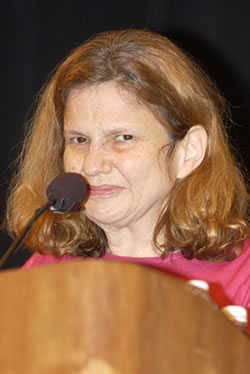Few mothers tell their children to grow up to be an artist or playwright. Parents give their daughters dance lessons and pay for acting classes so that they will, in the words of famed playwright Wendy Wasserstein, “grow up to become well-rounded doctors who love ballet.”
Yet, somehow, the girl who had no idea that someone could grow up to be an artist is hailed as one of the great writers of our time.

Wasserstein, who gave the annual Vivan R. Shaw lecture Wednesday night, addressed New York City living, her life in theater and how the two mesh.
Born in Brooklyn and raised on the Upper East Side, Wasserstein attended the Calhoun School, where she says she “began writing to get out of gym class.” Wasserstein went on to earn a degree in history from Mount Holyoke College in 1971 and post graduate degrees from the City College of New York and Yale School of Drama, which the playwright says she attended after applying to drama and business school, and going to the one that accepted her first.
In 1989, she became the first female playwright to win a Tony award for “The Heidi Chronicles.” She also won a Pulitzer Prize for that work. In addition to writing plays, Wasserstein has written books for children and adults and two collections of stories. She has served as editor for numerous magazines and has taught at Columbia, Princeton and New York universities.
Though she has lived other places, Wasserstein loves New York. She says the city has an infrastructure that allows a family to flourish, and she hopes it remains that way in the future. The daughter of an immigrant owner of a ribbon factory, Wasserstein grew up going to shows on Saturdays because her parents wanted her to experience all the city had to offer. This exposure to theater helped form her imagination and planted the seeds for her future career, she said.
In addition, Wasserstein saw the importance of female writers and their works. But she wanted more women’s voices in plays and other writings, and she wondered “where were all the women?” she said. Her goal was “to have an all woman’s curtain call in the basement of Yale Drama School.” She began writing comic works about women and their choices because she felt “comedy, especially women’s comedy, is very serious. … It’s about deflecting and why we deflect.” Wasserstein also wanted to see characters with whom she could identify, so she wrote such acclaimed works as “Uncommon Women and Others” and “The Heidi Chronicles.” She said her works, particularly “The Heidi Chronicles,” are meant to show “how the times you live in affect personal choices.”
Wasserstein’s life, involving both New York City and her career in theater, came together in a program that she created for young people. Years ago, she started the program in which she took eight students from a New York City public high school to eight plays throughout the year. The students, all of whom primarily focused their school careers and extracurricular activities on math and science, came to have a better understanding of their city through the plays.
Wasserstein said one student best summed up the experience when she said she previously felt New York was distant, but after going to the plays, she felt like a true New Yorker for the first time. Wasserstein also recalled an anecdote from a trip to Washington a few years ago, when she lobbied Congress for artist grants. While having lunch with a former congressman, she was told that her efforts were futile, and the congressman noted: “Arthur Murray never needed a grant to write a play.”
“If the people in charge of the arts don’t know the difference between Arthur Murray and Arthur Miller,” Wasserstein said, “the community needs to get involved.”

